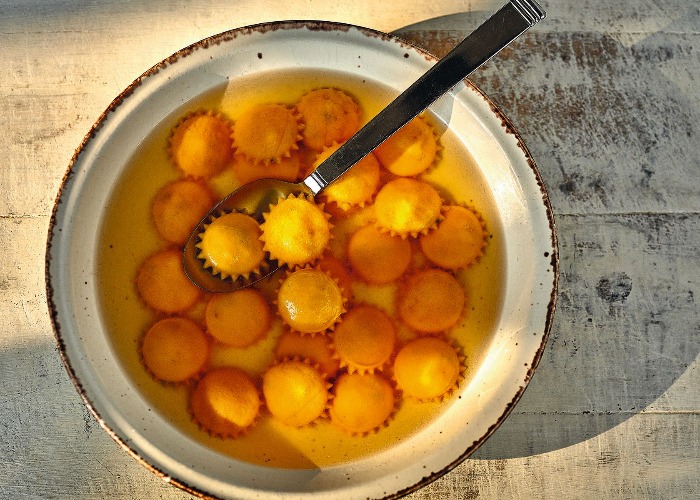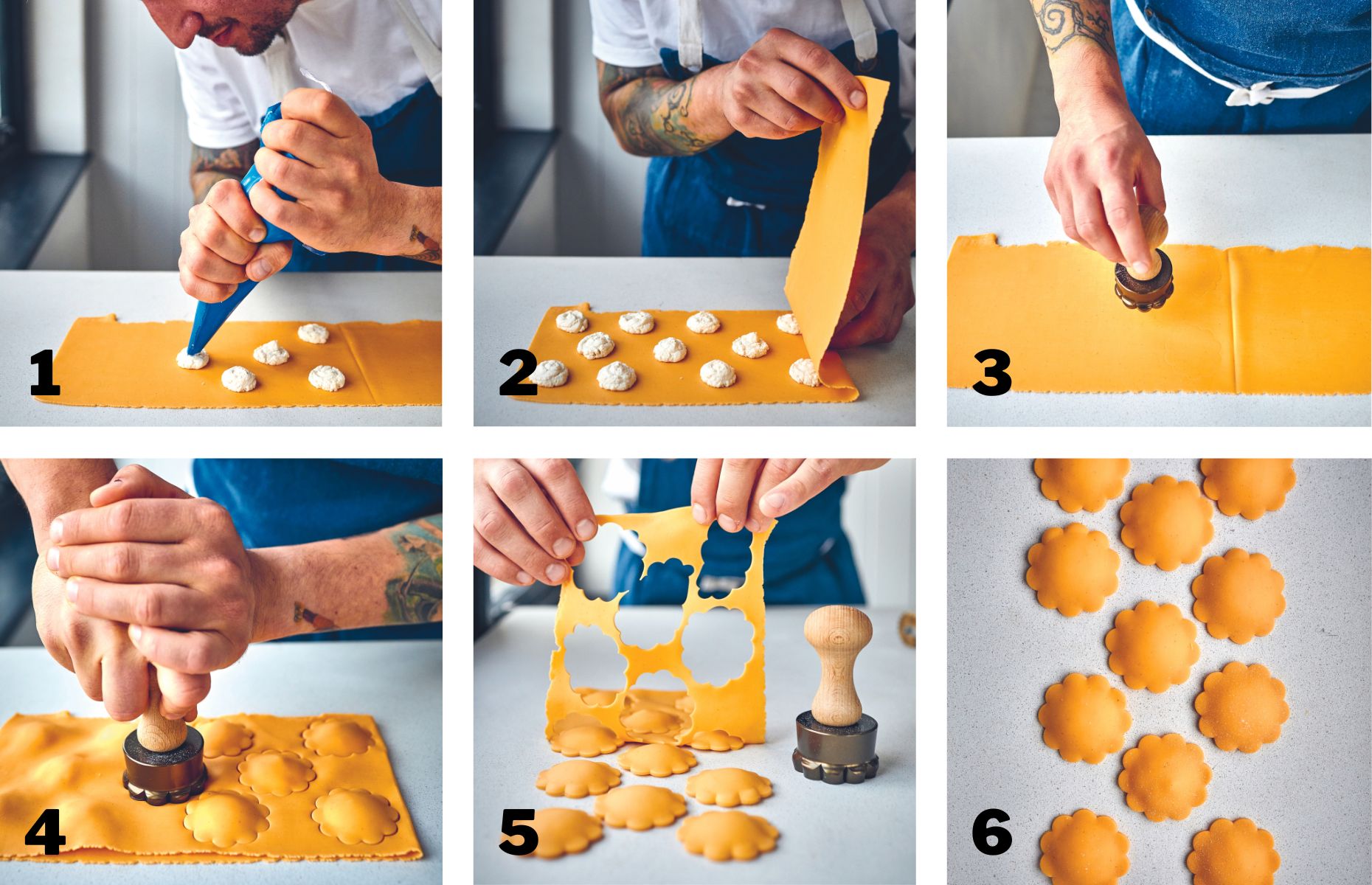The Pasta Man’s tarragon and mortadella anolini in brodo

Like many of Italy’s best recipes, anolini in brodo is beautiful in its simplicity. Born from a combination of high-quality ingredients, culinary traditions and, perhaps most importantly, the expertise and hard work of Italian nonnas, the meat-filled pasta is served swimming in a warm, crystal-clear meaty broth.
It’s a dish that’s typically reserved for special occasions, as it can be quite time consuming. The broth, which will carry the delicate pasta morsels, needs to simmer gently for several hours to achieve the perfect depth of flavour, while shaping the pasta requires a light touch and a little patience.
Mateo Zielonka, also known as The Pasta Man, shares his version of anolini in brodo in his new cookbook, Pasta Masterclass: Recipes for Spectacular Pasta Doughs, Shapes, Fillings and Sauces. Mateo is known for bringing creative flair to authentic pasta recipes, and has quickly become an authority on the art of pasta making.
Whether you save this recipe for a special occasion or just decide to treat yourself to a bowl, this is a dish that will nourish your soul. As Mateo adds: “It has the added advantage of bringing a hint of sunshine to your bowl, as the shapes are like small golden suns.”
Things to note:
Mortadella is often sold pre-sliced as it’s a popular sandwich filling. For this recipe, you want to ask for a chunk of mortadella at the deli counter. If they have ends available, even better; they’re often sold at a discount, and you’ll be chopping the meat anyway.
To make the pasta you'll need a pasta machine and an anolini stamp or a small cookie cutter.
You’ll need to rest the filling and the pasta dough for at least 30 minutes. You can make the dough a day or two ahead if preferred, as it will sit quite happily in the fridge for up to 48 hours.
The meat broth should ideally be made a day ahead and it will need to simmer for at least two hours – this is reflected in the cooking time, though ideally it should simmer for longer if possible. If you have more broth than you need for this dish, you can easily freeze any leftovers.
For US ingredients and measurements, use the drop-down menu and select 'Cups'.
Ingredients
- 280 g Italian 00 flour
- 2 eggs
- 4 egg yolks
- 9.9 oz Italian 00 flour
- 2 eggs
- 4 egg yolks
- 9.9 oz Italian 00 flour
- 2 eggs
- 4 egg yolks
- 1.5 kg chicken bones
- 1.5 kg beef bones
- 2 medium onions, roughly chopped
- 4 medium carrots, roughly chopped
- 0.5 head celery, chopped
- 1 garlic bulb, halved
- 4 bay leaves
- 1 tsp black peppercorns
- 1 Parmesan rind (optional)
- 4 l water, ice-cold
- 2 generous sprigs of rosemary
- 3 sprigs of thyme
- 1 handful parsley stalks (optional)
- 3.3 lbs chicken bones
- 3.3 lbs beef bones
- 2 medium onions, roughly chopped
- 4 medium carrots, roughly chopped
- 0.5 head celery, chopped
- 1 garlic bulb, halved
- 4 bay leaves
- 1 tsp black peppercorns
- 1 Parmesan rind (optional)
- 7 pints water, ice-cold
- 2 generous sprigs of rosemary
- 3 sprigs of thyme
- 1 handful parsley stalks (optional)
- 3.3 lbs chicken bones
- 3.3 lbs beef bones
- 2 medium onions, roughly chopped
- 4 medium carrots, roughly chopped
- 0.5 head celery, chopped
- 1 garlic bulb, halved
- 4 bay leaves
- 1 tsp black peppercorns
- 1 Parmesan rind (optional)
- 16.9 cups water, ice-cold
- 2 generous sprigs of rosemary
- 3 sprigs of thyme
- 1 handful parsley stalks (optional)
- 250 g mortadella
- 100 g ricotta
- 1 handful tarragon, finely chopped
- 1 lemon, juiced and zested
- 8.8 oz mortadella
- 3.5 oz ricotta
- 1 handful tarragon, finely chopped
- 1 lemon, juiced and zested
- 8.8 oz mortadella
- 3.5 oz ricotta
- 1 handful tarragon, finely chopped
- 1 lemon, juiced and zested
- 1 handful Parmesan
- 1 handful Parmesan
- 1 handful Parmesan
Details
- Cuisine: Italian
- Recipe Type: Pasta
- Difficulty: Hard
- Preparation Time: 110 mins
- Cooking Time: 170 mins
- Serves: 4
Step-by-step
For the meat broth:
- Preheat the oven to 200°C/180°C fan/400°F/gas mark 6.
- Place the bones in a large roasting tin (sheet pan) and roast in the oven for 40 minutes until golden brown.
- Place the chopped vegetables into a large stock pot with the garlic, bay leaves and peppercorns, adding the Parmesan rind if you have one.
- Pour in the ice-cold water which will bring out all the flavours in the pot.
- Add the roasted bones together with the fat from the bottom of the roasting tin.
- Bring the pot to a simmer and leave it to simmer for a minimum of 2 hours, but preferably 4-6 hours: the longer and slower, the better it will be.
- Skim off the fat from the surface of the stock from time to time.
- Add the rosemary and thyme sprigs (and the parsley stalks, if using) to the pot for the last 15 minutes of cooking time. This will add a lovely aromatic flavour to the broth.
- Take the pot off the heat and allow it to cool before straining the liquid into a large bowl, discarding the herbs and vegetables.
- Strain again using a large muslin cloth (cheesecloth) or tea (dish) towel; this will give you a nice clear broth which can now be placed in the fridge to cool completely.
For the rich egg dough:
- Tip the flour onto a clean work surface or board and shape it into a mound. Make a well in the centre and add the eggs and yolks into the middle. Using a fork, break the yolks and start to gently whisk them.
- Draw in the flour a little at a time and continue to combine with the fork. When everything starts to come together, use your hands to knead the dough for 8-10 minutes until smooth.
- Use the heel of one hand to push the dough away from you and use your other hand to turn it 90 degrees after each knead – you’ll soon develop a rhythm.
- When the dough is smooth, form it into a flat disc (this will make it easier to roll out later). Place it in an airtight container in the fridge to rest for at least 30 minutes.
For the filling:
- Roughly chop the mortadella into small pieces, then place them into the bowl of a food processor and blitz until they break up.
- Add the ricotta, tarragon, lemon juice and zest and blend until everything is well combined.
- Scoop the mortadella filling into a bowl, season it with sea salt and freshly ground black pepper and leave in the fridge for 30 minutes to firm up a little.
To shape the anolini:
- Start with a quarter of the dough, keeping the rest in an airtight container, and prepare a tray or baking sheet dusted with coarse semolina, on which to lay out your finished pasta.
- Roll out the dough to setting 7 on your pasta machine.
- Lay the rolled sheet on a clean work surface, fold it in half just to mark the middle of the length, then lay it flat again.
- Place the filling in rows to one side of your marked line. Pipe or spoon a cherry-sized amount onto the dough, leaving a finger-width space on each side, and continue along the rows until you’ve filled all the space you can.
- Carefully lift over the other half of the dough to cover, then just press between each mound to seal the outline of each shape.
- Now, using the anolini stamp, or a cookie cutter stamp the anolini. Gently lift away the off cuts of pasta, which you can ball together and re-roll. Continue to roll and shape the rest of the dough until you have a trayful of anolini.

Step-by-step anolini making (Photography: Dave Brown)
To serve:
- Reheat the broth. Remove and discard the layer of fat which will have settled at the top of the bowl. The broth itself will have the consistency of jelly but will loosen when it’s heated up again; season it to taste with sea salt and freshly ground black pepper.
- Set a large pan of water on the hob and, when the water is boiling, season it generously with table salt. Carefully drop in the pasta and cook for 1-2 minutes. Scoop out the pasta with a slotted spoon, or gently tip it into a colander to drain, then immediately divide it between four warmed bowls. While you can cook the pasta directly on the broth it is better to do it separately in case any of them split which will turn the clear broth murky.
- Ladle the hot broth over the anolini and finish with a generous grating of Parmesan.
Recipe adapted from Pasta Masterclass by Mateo Zielonka. (Quadrille, £26) Photography: Dave Brown
You might also like:
21 tips for cooking perfect pasta
Comments
Do you want to comment on this article? You need to be signed in for this feature